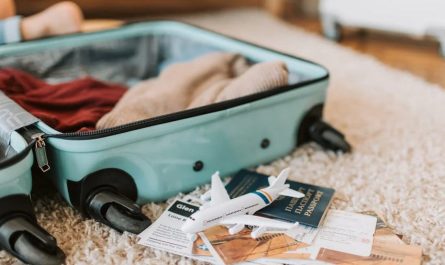Air Travel Rules: Can I Have a Carry-on, Backpack, and Purse Together?
Contents
- 1 How picky are airlines about carry-on size?
- 2 Unpacking the Essentials
- 3 Defining Your Carry-On and Personal Items
- 4 Can You Bring All Three?
- 5 Does a crossbody purse count as a carry-on?
- 6 Does ladies handbag count as hand luggage?
- 7 Does pillow count as hand luggage?
- 8 Can I bring two personal items on a plane?
- 9 Tips for Efficient Packing
The thrill of jet-setting to a new destination often comes with the slightly less glamorous task of packing. Yet, understanding what you can bring aboard can make this task a breeze and your travel experience smoother.
The majority of airlines permit travelers to carry both a personal item—such as a backpack, laptop bag, purse, briefcase, or shopping bag—and a carry-on piece of luggage. The key guideline to remember is that your personal item should be more compact than your carry-on and must be able to slide under the seat before you.
What is considered carry-on baggage?
Carry-on baggage refers to any luggage that you bring with you onto the plane. Typically, airlines permit one piece of carry-on luggage, often known as hand baggage, which must be small enough to store in the overhead compartment. In addition to this, passengers are allowed to bring a smaller personal item, such as a purse, laptop bag, diaper bag, or small backpack, which should fit under the seat in front of them.
How picky are airlines about carry-on size?
Airlines can be quite meticulous about carry-on size due to limited overhead bin space and safety regulations. Each airline has specific dimensions and weight limits for carry-on luggage, and they often enforce these rules strictly at the gate. Non-compliant bags may require checking at the passenger’s expense. However, enforcement can vary by airport, gate agents, and the flight’s fullness. To avoid surprises, it’s wise to check your airline’s carry-on policy before packing and aim to stay within their size and weight guidelines. Investing in luggage that fits these standards can make for a smoother travel experience.
Unpacking the Essentials
First off, the golden rule of air travel is that luggage allowances can vary widely between airlines. However, most airlines operate under a common understanding when it comes to carry-on luggage, allowing passengers to bring a carry-on bag and one personal item.
Defining Your Carry-On and Personal Items
Carry-On: This is typically your larger piece of luggage, a small suitcase, or a travel backpack, which you stow in the overhead bin. Dimensions and weight limits are airline-specific, so it’s crucial to check ahead of time.
Personal Item: Generally, a personal item is something smaller like a laptop bag, purse, or small backpack that fits under the seat in front of you.
Can You Bring All Three?
So, to the heart of the matter: Can a carry-on, a backpack, and a purse simultaneously grace your presence on a flight? The short answer is yes, but with a caveat. The backpack or purse would need to qualify as your personal item, and the other as your carry-on, assuming neither exceeds the airline’s size and weight restrictions. This means packing smartly to ensure all essentials are within reach but also that you’re not overburdened with too much carry-on luggage.
Does a crossbody purse count as a carry-on?
Absolutely, navigating the nuances of airline luggage policies can feel like a puzzle, but here’s a straightforward piece of the picture: A crossbody purse typically falls under the category of a “personal item” rather than a carry-on. The distinction lies in the size and purpose of the item.
A carry-on is generally larger, intended for the overhead bin, and can be a suitcase or a larger backpack. On the flip side, a personal item like a crossbody purse is smaller, designed to hold essentials such as your wallet, travel documents, and perhaps a few personal items, and it should fit comfortably under the seat in front of you.
This means you can usually bring a crossbody purse aboard in addition to your standard carry-on luggage, giving you a bit of extra packing flexibility. However, always check with your specific airline’s baggage policy to ensure your luggage setup flies smoothly with their regulations. Airlines have varying size and weight limits for both carry-on luggage and personal items, so confirming beforehand can save you time and potential hassle at the airport. Happy travels!
Does ladies handbag count as hand luggage?
In short, a ladies’ handbag typically counts as a personal item, not as your main hand luggage (carry-on). This means you can usually bring it on board in addition to your carry-on luggage, provided it fits under the seat in front of you. However, it’s always wise to check the specific airline’s policy to ensure compliance with their size and quantity restrictions for carry-on baggage and personal items.
Does pillow count as hand luggage?
A pillow often falls into a gray area in terms of hand luggage policies. Generally, airlines do not count a standard-sized travel pillow (the kind you wrap around your neck) as hand luggage or a personal item. You can typically bring it aboard in addition to your carry-on and personal item without any issues.
However, if you’re planning to bring a larger, standard bed pillow, some airlines might consider it as an additional personal item or part of your carry-on allowance, especially if you need to stow it in the overhead compartment or it significantly adds to your overall luggage bulk. It’s always best to check with the airline beforehand to understand their specific policy on pillows as hand luggage to avoid any surprises at the gate.
Can I bring two personal items on a plane?
Bringing two personal items on a plane instead of one personal item plus a standard carry-on bag varies by airline policy. Most airlines traditionally allow one personal item that must fit under the seat in front of you, in addition to one carry-on bag that goes in the overhead bin. The personal item is usually defined as a purse, laptop bag, small backpack, or briefcase.
However, some airlines might be more flexible and allow passengers to bring two personal items, especially if one is significantly smaller, like a small handbag or a compact camera bag, alongside a larger personal item. Budget airlines tend to have stricter policies and may only allow one personal item unless you pay for additional luggage allowances.
It’s crucial to check with your specific airline before traveling to understand their luggage allowances and avoid any additional fees or the need to check unexpected items at the gate. Remember, policies can vary widely, and what’s permissible on one airline might not be allowed on another.
Tips for Efficient Packing
- Consolidate: Consider if your purse can fit into your backpack or vice versa. This way, you’re maximizing your personal item allowance.
- Prioritize Essentials: Keep important documents, valuables, and essentials in your personal item for easy access.
- Check Airline Policies: Always verify the specific carry-on and personal item dimensions allowed by your airline. This can prevent any boarding gate surprises.
- Be Prepared for Exceptions: During peak travel times or on full flights, even if your items meet the size requirements, you might be asked to check in your carry-on.
Personal items
Personal items that passengers commonly carry on flights include items that are essential for comfort, entertainment, work, or personal needs during the journey.
Here’s a list of typical personal items you might see travelers bringing aboard:
- Backpack: A small to medium-sized backpack that can fit under the seat.
- Purse/Handbag: Often used for personal essentials such as wallets, passports, and travel documents.
- Laptop Bag: Designed to carry laptops, chargers, and sometimes work documents.
- Briefcase: Used for transporting documents, laptops, and other work-related items.
- Camera Bag: Small bag for a camera and photography equipment, depending on the hobbyist or professional needs.
- Small Duffel Bag: A compact version of a duffel bag that can fit under the seat, used for clothes or additional travel essentials.
- Travel Pillow: Neck pillows or small travel cushions for comfort during the flight.
- Food Container: Small snack boxes or food bags, especially for those with dietary restrictions.
- Personal Hygiene Kit: Small bag with essentials like a toothbrush, toothpaste, face wipes, and hand sanitizer.
- Medication Bag: Essential for those who need regular medication, often with a doctor’s note for prescription meds.
- Travel Document Holder: A compact organizer for passports, tickets, boarding passes, and visas.
While this list covers a range of commonly carried personal items, always remember to check the size and weight restrictions for personal items with your specific airline. Ensuring your personal item fits within these guidelines will help make your travel experience smoother and more enjoyable.
Final Thoughts
Navigating through airport security with a carry-on, a backpack, and a purse is definitely within the realm of possibility, but it requires a bit of strategic packing and familiarity with airline policies. Remember, the aim is to enhance your travel experience, not to pack your entire wardrobe. With a bit of planning, you can ensure that your journey starts off on a light and stress-free note.
So, fellow travelers, next time you’re plotting your aerial adventure, keep these insights in mind. Your perfect travel trio of a carry-on, backpack, and purse is not just a possibility but a practical way to carry your essentials into the skies. Here’s to packing smart and traveling light! 🌍✈️
Baggage RulesChecked Bag: Costs, Tips, and Tricks
Should I Lock My Suitcase When I Fly?
Airlines with free baggage
Flying with Oversize and Overweight Bags
Checked Luggage Restrictions
Hard or Soft Luggage?
Can I Trust My Bathroom Scale for Weighing Luggage
What happens if your checked luggage gets lost?
How many bottles of alcohol can I bring on a plane?
When does an airline consider a bag lost?
How to prevent your luggage from getting lost
Hacks To Beat Baggage Fees
How do you Fly with kids and car seats?





